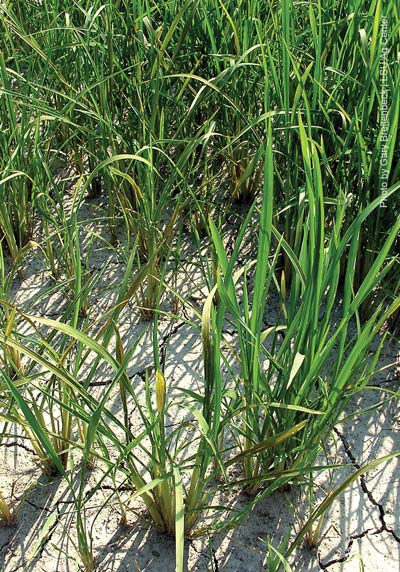Silicon (Si) deficiency
 Crops affected by Si deficiency have droopy leaves (Photo by Gary Breitenbeck, LSU AgCenter) What it does
Crops affected by Si deficiency have droopy leaves (Photo by Gary Breitenbeck, LSU AgCenter) What it does
Silicon (Si) deficiency affects the development of strong leaves, stems, and roots.
It also affects the formation of a thick silicated epidermal cell layer, and makes the rice plants susceptible to fungal and bacterial diseases, and insect and mite pests.
Why and where it occurs
Silicon deficiency is not very common in irrigated rice. It occurs in areas with poor soil fertility, and is common in old and degraded paddy soils.
It also occurs in organic soils with small mineral Si reserves, and in highly weathered and leached tropical soils in the rainfed lowland and upland areas.
How to identify
Check the field for the following symptoms:
- leaves and culms become soft and droopy thus increasing mutual shading
- reduced photosynthetic activity
- lower/reduced grain yields
- increased occurrence of diseases such as blast (caused by Pyricularia oryzae) or brown spot (caused by Helminthosporium oryzae)
Severe Si deficiency reduces the number of panicles and the number of filled spikelets per panicle. Si-deficient plants are also particularly susceptible to lodging.
To confirm Si deficiency, send soil and plant sample to laboratory for testing.
Why is it important
Silicon deficiency is not very common in irrigated rice and thus, to date, tends to be of little economic significance. Nonetheless, the damage caused by Si deficiency is important throughout the growth cycle of the rice crop.
How to manage
- In the long term, Si deficiency is prevented by not removing the straw from the field following harvest, and recycling rice straw (5−6% Si) and rice husks (10% Si).
- Where possible, apply substantial input of Si from irrigation water.
- If rice hulls or rice hull ash are available, recycle them to replenish Si in soil.
- Avoid applying excessive amounts of Nitrogen fertilizer.
- Where possible, apply calcium silicate slags regularly to degraded paddy soils or peat soils at a rate of 1−3 t ha-1.







